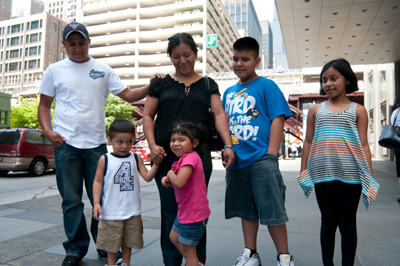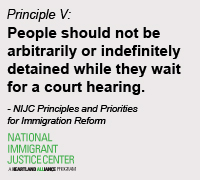Rethink Immigration is a new blog series in which National Immigrant Justice Center (NIJC) staff, clients, and volunteers share their unique perspectives and specific recommendations on what Congress and the Obama administration must include in comprehensive immigration reform to create an inclusive, fair, and humane immigration system. We hope to show the profound impact that our country’s complex and outdated immigration laws and decades of draconian enforcement have had on everyone in our society. Click here to read more about NIJC’s principles and priorities for immigration reform.
Last week, the Department of Homeland Security (DHS) released at least 2,000 people from detention centers across the country, including many in the Chicago area. DHS stated that the move was related to financial concerns in advance of spending cuts expected to occur under sequestration. DHS Secretary Janet Napolitano is quoted as saying, “I'm supposed to have 34,000 detention beds for immigration. How do I pay for those?”

Secretary Napolitano was referencing the so-called DHS detention bed quota. Congress has appropriated enough money — more than $2 billion — to detain 34,000 immigrants each night. The trouble with having a quota is that the decision of whether to detain a person is based on whether there is a bed that needs to be filled. Men and women are put in detention, torn from their families, and blocked from access to counsel not for the sake of public safety but so the government can meet an arbitrary goal of occupied detention beds. As Congress and President Obama legislate a new immigration system, sequestration might provide an unexpected yet valuable lesson: enforcing our country’s immigration laws need not rely on expensive detention that deprives people of basic rights.
DHS's Muddled Priorities
Typically, when making a custody determination, a DHS officer considers numerous factors, with emphasis on whether the individual is a flight risk or a danger to the community. Given that detaining an immigrant in DHS custody costs taxpayers
$164 per day per detainee (compared to alternative forms of custody that cost as little as 30 cents up to 14 dollars per day per person), it seems reasonable to expect that DHS would choose not to detain a person unless there was truly a compelling reason to do so.
But when officers feel they must meet a bed quota, the logic changes. Inevitably, DHS lowers its standard for who must be detained.

DHS documents leaked a few weeks ago to
USA Today revealed that immigration officers were pressured to meet deportation quotas by setting up traffic “seatbelt” checkpoints and combing driver’s license databases to find people to arrest. As a result, taxpayer dollars likely paid to put in costly deportation proceedings people whose only offense was not having immigration papers. In the detention context, we see similar poor decision making by DHS officers trying to fill bed space. Hard working men and women who could be supporting their families and contributing to our communities are instead languishing behind bars. In the past year in my detention work I have met a domestic violence victim picked up from her hospital room, a high school student who was weeks from graduation, a man who had been in the United States for 20 years and whose U.S. citizen wife was dying from lung disease, and the father of two toddlers whose U.S. citizen wife had cerebral palsy — to name only a few. None of these individuals had committed offenses worse than traffic tickets and none had prior immigration violations.
DHS has stated its intention to exercise prosecutorial discretion more broadly at all levels, from deciding whom to detain in the first place to deciding which cases are really priorities to pursue in court. But the goals of using prosecutorial discretion and simultaneously maintaining a daily detention population of 34,000 people are obviously at odds with each other. DHS officers cannot find 34,000 dangerous criminal immigrants to meet its arbitrary quota, so it continues to detain many
people who do not have criminal convictions or who have been convicted of only minor offenses. Prosecutorial discretion at the court level has been granted in
less than two percent of cases.
Prolonged Detention Denies Justice
In cases where individuals might qualify for bonds, DHS attempts to keep them detained by ordering bonds their families cannot afford. The minimum immigration bond is $1,500, and anything up to $3,000 is considered a “low” bond. For many working class families even this is a huge amount of money, particularly when the detained individual is the main source of income. High bonds lead to the lengthy and expensive detention of people who are neither flight risks nor threats to the community.
One client I worked with was the only breadwinner in his family. His U.S. citizen wife could not work due to a disability, and she and their two young children had to move in with her parents because she could no longer pay rent after DHS detained her husband. The only way they might have been able to pay the bond was by selling the vehicle they used to get to medical appointments. As a result, our client remained detained for five months until he won his case.
Prolonged detention becomes traumatic for immigrants and their families. It also adds
significant barriers to success in court. People who might be able to win their cases if they were allowed to pay reasonable bonds, released on their own recognizance, or permitted to participate in some other alternative form of custody will lose because they are detained. In detention, it is harder for people to find and communicate with lawyers (85 percent of detained immigrants have no legal representation), let alone gather the documentation and evidence they need to prove to a judge that they have a right to stay in the United States. I spoke with one man who received the horrifying news shortly after he was detained that his preteen daughter had attempted suicide due to the emotional impact of his detention. In the fallout from this crisis, the daughter’s mother was no longer able to pay for phone service, and the man was unable to communicate with his family for months — and therefore was unable to get the documents he needed to fight his case.
On the other hand, under current DHS practices, each person who does pay his or her bond represents another bed that DHS has to hurry and fill again, meaning that more and more people are detained.
Congress Can Fix This
It is time for legislators to eliminate the detention bed quota. Congress should clarify appropriations language to allow DHS officers to use the money for alternative forms of custody and instruct the agency to maximize the use of those alternatives.
The fact that DHS was able to release so many people from detention last week and rely on other methods to ensure they go to court shows how easily it can be done. It not only makes financial sense for taxpayers, but also is necessary to ensure justice and due process for immigrants and their families. I expect that we will soon be hearing stories from clients whose families were reunited and who were able to better defend their cases as a result of sequestration.
Elizabeth Kalmbach is the detention and due process coordinator for Heartland Alliance’s National Immigrant Justice Center, where she organizes Know Your Rights visits and provides legal consultations to immigrants detained at six county jails in Illinois, Wisconsin, and Kentucky.
Rethink Immigration is a blog series in which National Immigrant Justice Center staff, clients, and volunteers share their unique perspectives and specific recommendations on what Congress and the Obama administration must include in comprehensive immigration reform to create an inclusive, fair, and humane immigration system.
 Secretary Napolitano was referencing the so-called DHS detention bed quota. Congress has appropriated enough money — more than $2 billion — to detain 34,000 immigrants each night. The trouble with having a quota is that the decision of whether to detain a person is based on whether there is a bed that needs to be filled. Men and women are put in detention, torn from their families, and blocked from access to counsel not for the sake of public safety but so the government can meet an arbitrary goal of occupied detention beds. As Congress and President Obama legislate a new immigration system, sequestration might provide an unexpected yet valuable lesson: enforcing our country’s immigration laws need not rely on expensive detention that deprives people of basic rights.
Secretary Napolitano was referencing the so-called DHS detention bed quota. Congress has appropriated enough money — more than $2 billion — to detain 34,000 immigrants each night. The trouble with having a quota is that the decision of whether to detain a person is based on whether there is a bed that needs to be filled. Men and women are put in detention, torn from their families, and blocked from access to counsel not for the sake of public safety but so the government can meet an arbitrary goal of occupied detention beds. As Congress and President Obama legislate a new immigration system, sequestration might provide an unexpected yet valuable lesson: enforcing our country’s immigration laws need not rely on expensive detention that deprives people of basic rights.

